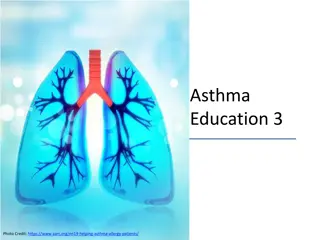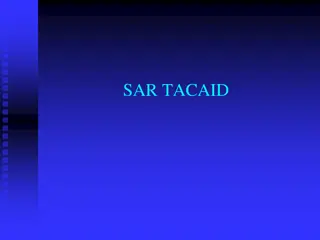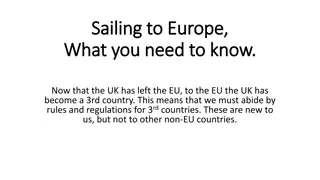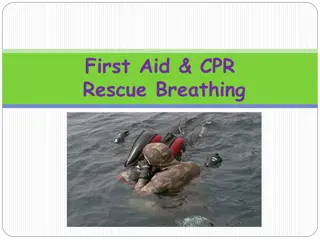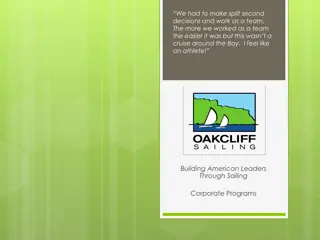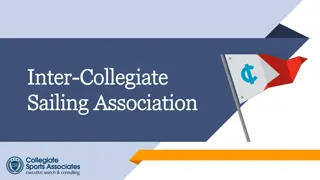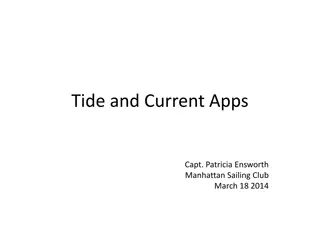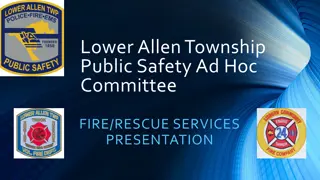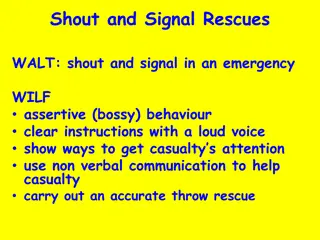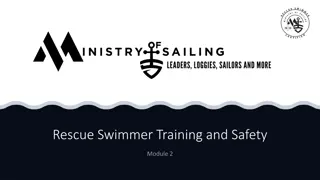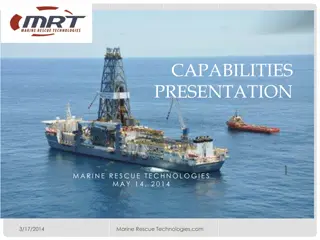Comprehensive Training for Sailing Rescue Swimmers
Explore the essential learning objectives for Rescue Swimmers and Principal Race Officers, focusing on the distinctions between Rescue Swimmers and Surface Swimmers, crew and boat readiness terminology, certification processes, roles and responsibilities, risk management, and the importance of avoiding unproven methods. Discover the critical skills needed to become a certified Sailing Rescue Swimmer and maintain crew readiness for emergency responses while mitigating risks effectively.
Download Presentation

Please find below an Image/Link to download the presentation.
The content on the website is provided AS IS for your information and personal use only. It may not be sold, licensed, or shared on other websites without obtaining consent from the author.If you encounter any issues during the download, it is possible that the publisher has removed the file from their server.
You are allowed to download the files provided on this website for personal or commercial use, subject to the condition that they are used lawfully. All files are the property of their respective owners.
The content on the website is provided AS IS for your information and personal use only. It may not be sold, licensed, or shared on other websites without obtaining consent from the author.
E N D
Presentation Transcript
Learning Objective The Rescue Swimmers/Principal Race Officers will be able to: Demonstrate knowledge and understanding of: The differences between a Rescue Swimmer and a Surface Swimmer Terminology of crew and boat readiness Methods that maintain the crew readiness The need for the use of a Sailing Rescue Swimmer The qualification and certification process to become a RS Importance of certification The roles and responsibilities of the rescue swimmer Reasons sailors should refrain from employing unproven methods Ways a rescue swimmer can mitigate the urge to take short cuts in safety situations.
Sailing Rescue Swimmer: is a designation given to a technical expert trained to leave a vessel - while attached to a rescue line - and swim away from the boat to retrieve a Person in the Water. The differences between a Rescue Swimmer and a Surface Swimmer Sailing Surface Swimmer: is the designated crew member that is using a technique to give aid when a person is lowered from the deck near to or into the water. The intent is a longer reach to assist a PIW. IMPORTANT The definitions of Rescue Swimmers and a Surface Swimmers are recognized industry terms used by Rescue, Military and Security Forces around the world.
Crew Readiness is when the crew has mastered: Rescue operations Safety communications Teamwork Managing of resources and personnel training in preparation for responding to emergencies. Terminology of crew and boat readiness Boat Readiness refers to the operational conditions of: PPE and functional equipment The boat is equipped with all the kit needed to prevent COBs Ocean Racing mandates that time is always of the essence in emergencies, especially when lives are in jeopardy. It is the Rescue Swimmers purpose to lead the crew to maintain a constant state of readiness.
There will be risk. Sending a second sailor into the water increases the risk to an already difficult situation. This training program provides training to control the risks. The Sailing Rescue Swimmer, in combination with a trained team, are game changers. The certification program provides the training, procedures, and equipment needed to mitigate the additional risk associated by sending a second soul into the water. By using the training procedures and protective equipment, sending in a second soul to rescue a PIW is now a viable option while controlling the risk. Risks from using unproven methods DO NOT SEND A PERSON INTO THE WATER, TO SAVE ANOTHER WITHOUT PRACTICED PROCEDURES, PPE AND A TRAINED RESCUE PERSON
Modern sailboat performance characteristics have evolved to a point that enable far more effective rescue techniques than current standard practices if experiencing Crew Overboard (COB) situations. Sailing Rescue Swimmers, in combination with a trained crew, are the game changers which will add more options for rescuing a sailors who are in the water. Enhanced performance boats increase the distance separating the Person in the Water from the boat. Crews do and will continue to lose sight of the Person in the Water (PIW). The need for Sailing Rescue Swimmers
Controlling a vessel at high speeds with two or even three headsails deployed can take up to 20 minutes (or more). In 2014, during the Clipper Race in 2014, it took thirty minutes to find the PIW - and when they did, the PIW was unable to help themselves due to hypothermia. Sometimes, it may be impossible to rescue or even recover a PIW without the utilization of a Surface or Rescue Swimmer. Without practice, training and specialized equipment, sending a second person into the water may increase risk in a way that cannot be controlled. Some even suggest the risk is being doubled. However, through training, expert advice, procedures, certification, proven methods, and equipment the additional risk can be controlled. The need for Sailing Rescue Swimmers (2)
The Sailing Rescue Swimmer certification creates the highest trained safety professional aboard a boat. It provides a commitment to safety leadership coincides with the certification, no matter which vessel you sail. It is expected each Rescue Swimmer will lead the way to safety on every boat they sail on. The Rescue Swimmer is a certified, deployable team member, responsible for the rescue readiness of the boat, crew and in the execution of rescuing activities. The need for Sailing Rescue Swimmers (3)
Professional certifications provide: Standardized processes, equipment and training. A framework for controlling the risk through training, procedures, and equipment rather than controlling the risk through avoidance alone. Techniques that are vetted and tested by professionals, are used by professional teams, and that provide a consensus of acceptable practices. What the Sailing Rescue Swimmer Certification provides.
1) CPR and First Aid Qualified* 2) Safety at Sea Certificate* 3) Life-Guard Certification or evidence provided of strong swimming skills in open water (the ability to swim 400 meters, and the ability to tread water for 20 minutes). 4) A recommendation from a World Sailing, Group Three Professional or Team Captain/Owner providing evidence of experience. 5) Sailing experience not less than 150 nautical miles, or a passage not less than 24 hours. (* as recognized by World Sailing) Qualifications to become a Rescue Swimmer
Under the command of the Skipper, it is the Rescue Swimmer who is responsible for readiness in Person in Water (PIW) situations. Deployment, training, administration, personnel management, and logistics in all matters relating to PIW situations. Planning, training, making timely decisions, organizing and assigning tasks, and supervising the safety related activities. Keeps the team informed of latest information and review incident of COB situations. Plan COB drills and other safety training. Roles and responsibilities of the Rescue Swimmer
Stays abreast of sailing objectives through close coordination with Watch Captains and Team Leadership. Directs, trains, and assists the planning and coordinating the team s medical and emergency plans, reviews sailing instructions and safety requirements, ensure comprehension, and team implementation. Ensures that all-round safety maintenance is operational and up to date, provides task organization and corrects unsatisfactory actions. Positions oneself where they can influence the most critical tasks for mission safety. Roles and responsibilities of the Rescue Swimmer (2)
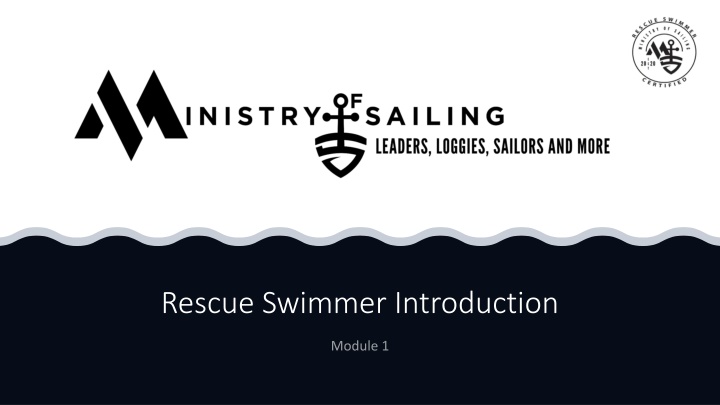


![READ⚡[PDF]✔ Solar Sailing: Technology, Dynamics and Mission Applications (Spring](/thumb/21622/read-pdf-solar-sailing-technology-dynamics-and-mission-applications-spring.jpg)

